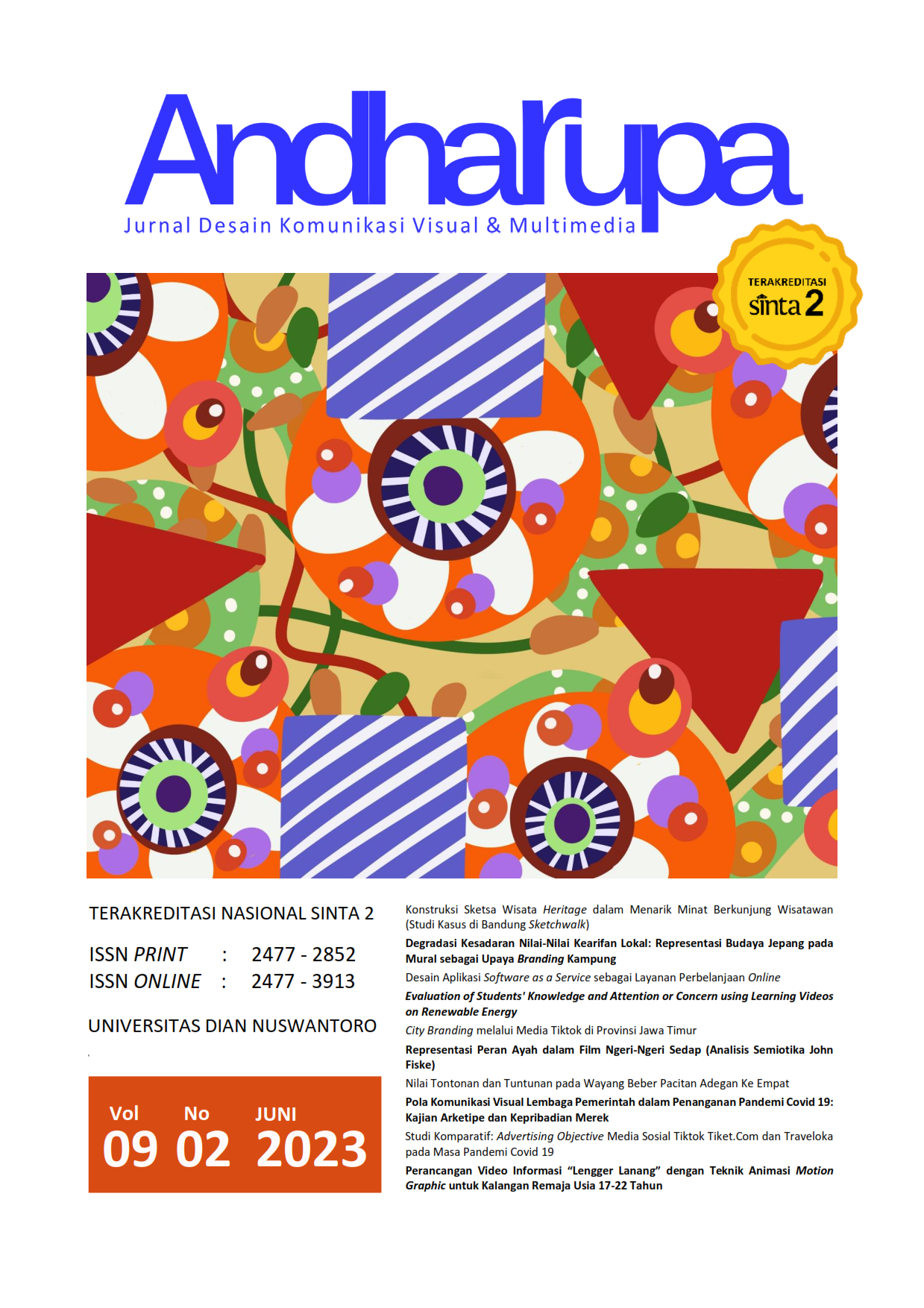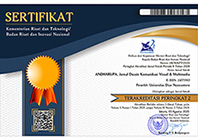Konstruksi Sketsa Wisata Heritage dalam Menarik Minat Berkunjung Wisatawan (Studi Kasus di Bandung Sketchwalk)
DOI:
https://doi.org/10.33633/andharupa.v9i02.7270Abstract
AbstrakWisata heritage merupakan salah satu jenis wisata yang mengalami pertumbuhan di beberapa negara yang memiliki keragaman dan keunikan warisan budaya. Popularitas wisata heritage memberikan kontribusi kepada peningkatan citra kota. Pengembangan wisata heritage memerlukan pola dan media promosi yang menarik dari berbagai perspektif. Sketsa menjadi salah satu media kesadaran wisata komunitas yang menarik untuk mempromosikan wisata heritage. Tujuan penelitian ini adalah untuk memahami kondisi dan makna bangunan heritage dari perspektif pelaku sketsa, proses penciptaan sketsa objek heritage, dan konstruksi sketsa objek heritage sebagai media kesadaran wisata komunitas dalam mempromosikan wisata heritage di Kota Bandung. Penelitian ini menggunakan metode kualitatif dengan pendekatan studi kasus. Data penelitian diperoleh melalui observasi, wawancara mendalam, dan studi dokumentasi. Informan yang dilibatkan dalam penelitian ini berjumlah sepuluh orang dari komunitas Bandung Sketchwalk. Data dalam bentuk karya sketsa dianalisis melalui analisis empat situs Rose dan analisis semantik Charles Sanders Peirce. Hasil penelitian menunjukkan bahwa objek bangunan heritage relatif masih terawat baik berdasarkan perspektif pelaku sketsa. Bangunan heritage ini menjadi sumber informasi, pengetahuan sejarah, dan penanda kota meskipun sifatnya masih berbentuk benda diam yang belum terintegrasi menjadi sistem pengembangan wisata heritage. Konstruksi sketsa wisata heritage dalam menarik minat berkunjung wisatawan memiliki karakteristik elemen visual hipoikon dengan indeksikalitas tanda figuratif dan tanda abstrak yang representatif untuk menginformasikan situs wisata sejarah, arsitektural, industri, museum, dan konser/teater melalui bangunan heritage di Kota Bandung. Beberapa pengembangan yang dapat ditindaklanjuti dari hasil penelitian ini adalah perencanaan rute tematik wisata minat khusus berbasis heritage, perancangan konten pemasaran wisata heritage dengan menggunakan media sketsa, karakteristik wisatawan serta pengelolaan kawasan heritage sebagai kawasan wisata yang terpadu dan berkelanjutan. Kata Kunci: Bandung Sketchwalk, Konstruksi Sketsa, Urban Sketch, Wisata Heritage AbstractHeritage tourism is a type of tourism that is experiencing growth in several countries that have a diversity and uniqueness of cultural heritage. The popularity of heritage tourism contributes to the improvement of the city's image. The development of heritage tourism requires attractive promotional patterns and media from various perspectives. Sketches are one of the interesting media for community tourism awareness to promote heritage tourism. The purpose of this study was to understand the condition and meaning of heritage buildings from the perspective of the sketch artist, the process of creating heritage object sketches, and the construction of heritage object sketches as a medium for community tourism awareness in promoting heritage tourism in the city of Bandung. This study uses a qualitative method with a case study approach. Research data were obtained through observation, in-depth interviews, and documentation studies. There were ten informants involved in this study from the Bandung Sketchwalk community. Data in the form of sketches were analyzed through Rose's four-site analysis and Charles Sanders Peirce's semantic analysis. The results showed that heritage building objects were relatively well preserved from the perspective of the sketch artist. These heritage buildings are a source of information, historical knowledge, and city landmarks, although they are still in the form of stationary objects that have not been integrated into a heritage tourism development system. The construction of heritage tourism sketches in attracting visiting tourists has the characteristics of visual elements hypo icons with indexicality of figurative signs and representative abstract signs to inform historical, architectural, industrial, museum, and concert/theater tourism sites through heritage buildings in the city of Bandung. Several developments that can be followed up from the results of this research are heritage-based special interest tourism thematic route planning, designing heritage tourism marketing content using sketch media, tourist characteristics and managing heritage areas as integrated and sustainable tourism areas. Keywords: Bandung Sketchwalk, Heritage Tourism, Sketch Construction, Urban SketchReferences
Alwasilah, A. C. (2003). Pokoknya Kualitatif. Jakarta: Pustaka Jaya.
Antara News. (2015). UNESCO umumkan Bandung masuk dalam jaringan kota kreatif. https://www.antaranews.com/berita/534718/unesco-umumkan-bandung-masuk-dalam-jaringan-kota-kreatif
Arifin, Z. (2011). Penelitian Pendidikan. PT Remaja Rosdakarya.
Arnheim, R. (1954). Art and Visual Perception. Berkeley, CA: University of California Press.
Benjamin, W. (1973). The Work of art in the age of mechanical reproduction, in H.Zohn (trans.) illuminations (pp. 219–253). Fontana.
Danesi, M. (2011). Pesan, Tanda, dan Makna. Yogyakarta: Jalasutra.
Danurdara, A. B. (2015). Perencanaan Produk Paket Wisata Heritage di Paguyuban Pelestarian Budaya Bandung. Jurnal Kepariwisataan Indonesia, 1, 17–32.
Hansen, M. B. (2008). Benjamin aura, Critical Inquiry (pp. 336–375).
Huibin, X., Marzuki, A., & Razak, A. A. (2013). Conceptualizing a sustainable development model for cultural heritage tourism in Asia. Theoretical and Empirical Researches in Urban Management, 8(1), 51–66.
Maher, K. H., & Carruthers, D. (2014). Urban Image Work: Official and Grassroots Responses To Crisis in Tijuana. Urban Affairs Review, 50 (2), 244–268.
Mc Kercher, B., & Du Cross, H. (2002). Cultural Tourism The Partnership Between Tourism and Cultural Heritage Management. The Howarth Press, Inc.
Nöth, W. (2011). Visual Semiotics: Key Features and an Application to Picture Ads. In The SAGE Handbook of Visual Research Methods (pp. 298–316). SAGE publications Ltd: London.
Rahardjo, M. (2018). Paradigma Interpretif. Jurnal Penelitian Sejarah Dan Budaya, 4(1), 1032–1047.
Richards, G. (2018). Cultural tourism: A review of recent research and trends. Journal of Hospitality and Tourism Management, 36, 12–21.
Rose, G. (2016). Visual Methodologies: An Introduction to Researching with Visual Materials. SAGE publications Ltd: London.
Suryabrata, S. (1987). Metode Penelitian. Jakarta: Rajawali.
UNESCO. (2006). Towards Sustainable Strategies for Creative Tourism. Discussion Report of the Planning Meeting for 2008 International Conference on Creative Tourism, Santa Fe, New Mexico, U.S.A., October 25-27, 2006. URL: http://unesdoc.unesco.org/images/0015/001598/159811E.pdf. (6/05/2021)
Downloads
Published
Issue
Section
License
Authors who publish with this journal agree to the following terms:
- Authors retain copyright and grant the journal right of first publication with the work simultaneously licensed under a Creative Commons Attribution License that allows others to share the work with an acknowledgment of the work's authorship and initial publication in this journal.
- Authors are able to enter into separate, additional contractual arrangements for the non-exclusive distribution of the journal's published version of the work (e.g., post it to an institutional repository or publish it in a book), with an acknowledgment of its initial publication in this journal.
- Authors are permitted and encouraged to post their work online (e.g., in institutional repositories or on their website) prior to and during the submission process, as it can lead to productive exchanges, as well as earlier and greater citation of published work (See The Effect of Open Access).















